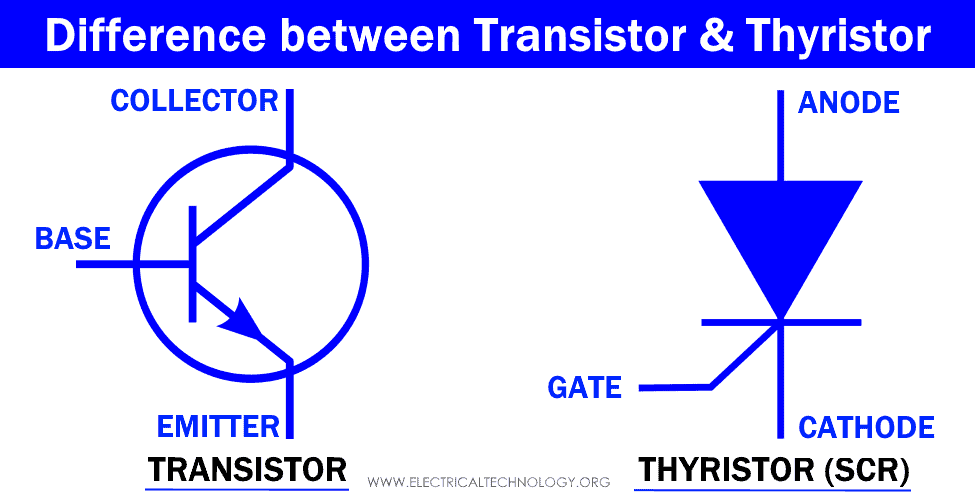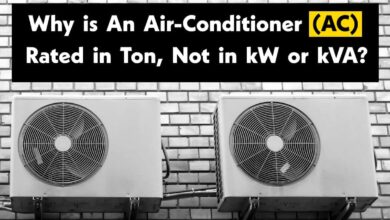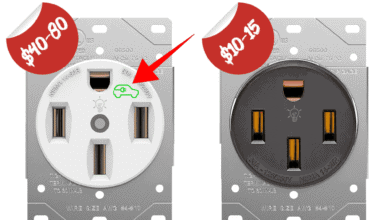What is The Difference Between Transistor & Thyristor (SCR)?
Key Differences between Transistor and Thyristor “SCR”
Switches are very extensively used in electrical and electronics engineering. Transistor and thyristor are both solid-state devices made of semiconductor material i.e. P-Type and N-Type semiconductor material. They are used for their superior and silent switching operations.
These both are three-terminal (Three-legged) devices having high switching speed with low weight and requiring very low maintenance. They are used instead of electrochemical switches. However, transistor and thyristor are quite different and each one of them is used in their own areas of applications.
Before going into the list of differences between transistor and thyristor, we are going to discuss their basics first.
Transistor
The transistor is a three terminals semiconductor device used for switching and amplification of a signal. It is a three-layered semiconductor device made of 3 semiconductor layers. As the layers used are different types of semiconductors i.e. N-type and P-type. Therefore, transistors have two types i.e. PNP and NPN transistors. The type of the transistor depends on its construction and also affects the type of majority carriers in it.
The following figure given below shows the structure and a symbolic representation of a transistor.
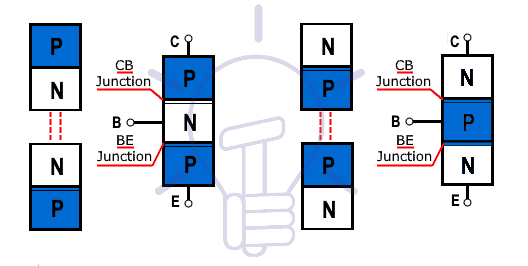
If a transistor is properly biased (applying a gate signal), it will start conduction of majority carriers from one end to another. However, the gate signal is continuous and must not be removed during operation. A transistor does not conduct in the absence of the gate signal.
The transistor starts conduction when the Base-Emitter junction is in forward bias and the Collector-Base junction is in reverse bias.
Transistors are mainly used for magnifying or amplification of small signals such as in audio amplifiers and also used as switches etc.
Since they are only used for switching or small-signal amplification therefore they are designed for low power applications and are rated in Watts. However, they are quite small in size as compared to the thyristor.
Related Posts:
- PNP Transistor? Construction, Working & Applications
- NPN Transistor? Construction, Working & Applications
Thyristor
The thyristor or SCR is a three-terminal semiconductor device used for switching. It is also known as SCR (Silicon Controlled Rectifier) because it can convert AC into unidirectional DC whose power can be controlled. It is a four-layered device i.e. PNPN.
The following figure given below shows the structure and a symbolic representation of a thyristor.
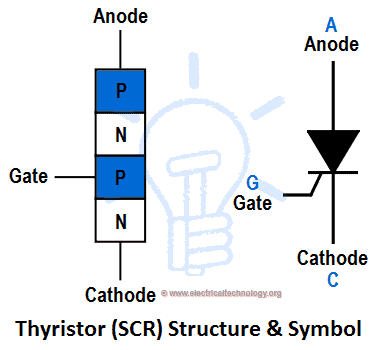

Since the thyristor does not stop conduction when the gate signal is removed, it needs extra circuitry to turn off the thyristor at command.
Thyristor or SCR is mainly used for controlled rectification and to control the power supplied to any load such as in lamp dimming, regulators and motor control.
The Thyristors are used for managing and controlling the large power, therefore they are rated in Kilowatts. and they are bulkier in size as compared to a transistor.
Differences between Transistor & Thyristor
The following comparison table shows some of the main differences between a transistor and a thyristor.
| Transistor | Thyristor |
| It is a 3-layered semiconductor device | It is a 4-layered semiconductor device. |
| It has 3 terminals i.e. emitter, base and collector. | It has 3 terminals i.e. Anode, Gate and Cathode. |
| It can be used for amplifying small signals as well as switching. | It cannot amplify any signal however it is only used for switching. |
| It has two types based on its construction i.e. PNP and NPN. | It has only one type based on its construction PNPN. |
| It requires a continuous gate signal in order to conduct. | It only needs a triggering pulse at the gate to start conduction. |
| The transistor turns on and turns off immediately. | The thyristor has a high turn-on and turn-off time. |
| It does not require any turn-off circuitry. | It requires an extra turn-off circuit to stop conduction at command. |
| The output current of the Transistor is proportional to its input current. | Its conduction cycle (power supplied) depends on the delay of the trigger pulse. |
| Transistor has a low voltage drop as compared to the thyristor. | It has a high voltage drop as compared to the transistor. |
| The internal power losses are higher as compared to a thyristor. | The internal power losses are lower as compared to a transistor. |
| Transistor has comparatively low efficiency. | It has comparatively higher efficiency. |
| It is a current-controlled device that continuously relies on an input current signal. | It is a latching device that momentarily needs a trigger pulse for operation. |
| They have low output power thus having low power ratings in watts. | They control high power having power ratings in kilowatts. |
| They are sensitive and cannot tolerate high surge current. | Thyristors are designed to handle high current surges. |
| They have a small size as compared to thyristor. | They have a large size as compared to transistors. |
| The transistors are cheaper than thyristors. | The thyristor is more costly as compared to a transistor. |
| It is best suited for high frequency and low power applications. | It is best suited for low frequency and high power applications. |
| It is used for switching and amplification of signals. | It is used for switching mostly in rectifiers and power control applications. |
Related Posts:
- Difference Between Microprocessor and Microcontroller
- Difference Between 8085 & 8086 Microprocessor – Comparison
Properties & Characteristics of Transistors & Thyristors
The following different properties differentiate both transistors and thyristors having different characteristics and applications.
Design
Based on the design, thyristor and transistor are different from each other. The transistor is made from 3 layers of alternating P-Type and N-Type semiconductor material. Therefore, transistors can be of two types PNP and NPN. On the other hand, a thyristor is made of 4 layers of alternating P-Type and N-Type semiconductor material. You could also say that a thyristor is made of two tightly bounded (PNP & NPN) transistors.
Terminal
Transistor and thyristor both are three-terminal devices i.e. they are 3-legged components. The 3 terminals of the transistor are collector, base and emitter. A signal at the base terminal controls the current flow between collector and emitter.
In a thyristor, the three terminals are anode, gate and cathode. A pulse at the gate terminal triggers the current flow between anode and cathode.
Operation
A transistor starts conduction when a pulse is applied at its base terminal. However, to keep it in conduction state, it requires a continuous supply of base signal.
A thyristor on the other hand only requires a momentary gate pulse to latch the device into the conduction state.
Voltage & Current Rating
The voltage and current ratings of a transistor and thyristor depends on its design. Although it is one of many features that differentiate between them. A thyristor is typically designed to operate on high voltage and current ratings as compared to a transistor.
Power Rating
The power handling capability of the transistor differs from thyristor. The transistors have comparatively very low power ratings in Watts. While thyristors are designed to operate and handle high power in ranges of Kilowatts KW.
Current Surge Handling
Transistor does not possess surge current handling capability as they are designed for low current and they can only tolerate a small rate of change of current. On the other hand, thyristors are designed to handle high surge currents.
Commutation Circuitry
As we know, Transistor automatically switch-off and stops conduction once the base signal is removed. But thyristor remains in a conduction state even after the removing of the gate signal.
Therefore, the thyristor requires extra commutation circuitry for switching off the thyristor on command.
Related Posts:
- Difference Between CPU and GPU – Comparison
- Difference between Analog and Digital Circuit – Digital vs Analog
Internal Losses
There are internal power losses in both transistor and thyristor. But the losses in a transistor are higher than that in a thyristor. Therefore, transistors have low efficiency as compared to thyristors.
Size
A circuit made from transistors and thyristors differs from each other in size. Transistors are smaller in size while thyristors are bulkier. Therefore, a circuit made from a transistor will be more compact and small in design as compared to the one made from thyristor.
Cost
Based on their cost, a circuit made from transistors is cheaper than the one made from thyristor because transistors are comparatively smaller and cheaper.
Switching Speed
The transistor can switch on and switch off very quickly having a very high switching speed. Therefore, they are perfect for high-frequency application
The thyristor cannot switch as fast as compared to a transistor. They have low switching speed that is why they are not suitable for high-frequency applications.
Power Handling
Since thyristors are designed to carry high current at high voltages. They are capable of handling very high power. Thus they are best suited for high-power applications.
While the transistor operates at very low current and voltage, it cannot handle high power. Therefore, they are used for low-power applications.
As an Amplifier
An amplifier is a device that magnifies small signals into a large signal. A transistor can be used as an amplifier for a small signal while a thyristor cannot perform such amplification.
Related Posts:
- Difference between Electron Current and Conventional Current
- Difference Between RAM and ROM – Comparison
- Difference Between Synchronous and Asynchronous Transmission
- Difference between Inverter & UPS – Uninterruptible Power Supply
- Difference Between Online UPS and Offline UPS – Which One is Better?
- Bipolar Junction Transistor (BJT) – Formulas and Equations
- Thyristor, SCR, DIAC and TRIAC Symbols
- Transistor, MOSFET and IGFET Symbols
